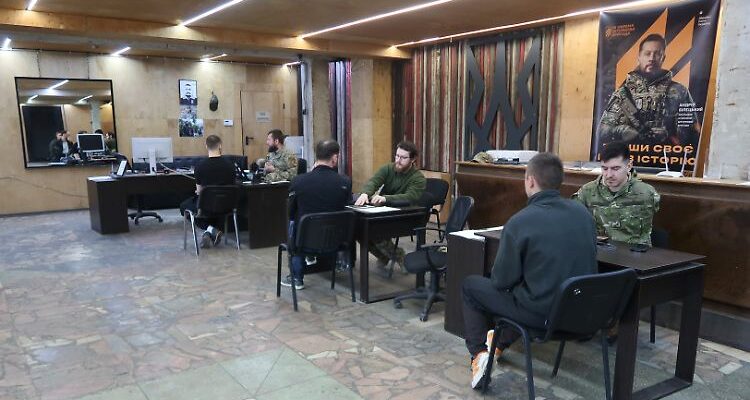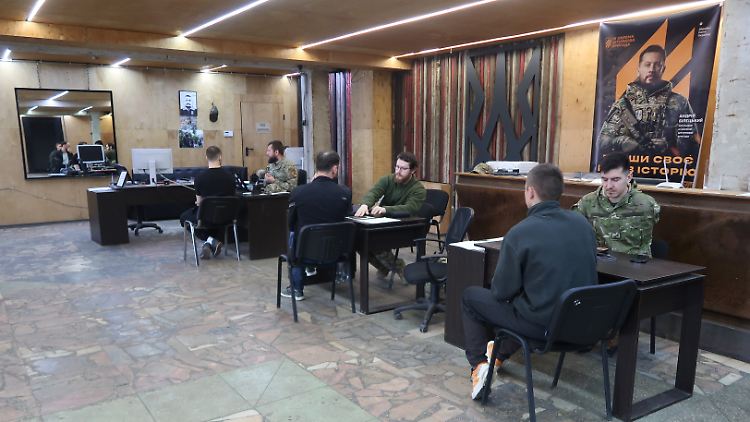The third assault brigade presents itself as an elite unit of the Ukrainian armed forces. In Kiev, the volunteer unit operates one of three recruitment centers. The association particularly attracts young people. A site visit.
Anyone driving through Kiev these days can hardly miss them: large billboards on all of the metropolis’s major roads advertise service in the third assault brigade. The regular volunteer unit of the Ukrainian army has a reputation for being an elite unit. Last summer, the brigade played a prominent role in the counteroffensive in the Bakhmut area. After the fall of Avdiivka in mid-February, she covered the retreat of the Ukrainian defenders. The association maintains a recruiting center on the outskirts of Kiev. Already early in the morning, a dozen young men and women are waiting at the gates to sign up to fight against the Russian invaders.
“We are looking for people who have the will to defend their family and their country,” says the head of the recruiting center, Danylo Kowal. “We offer a wide range of jobs, from mechanics and logisticians to drone pilots and assault soldiers.” The search for young talent is particularly successful on social networks. The Telegram channel The brigade has almost 300,000 followers and regularly publishes videos of operations in the combat zone.
The association particularly attracts young people. The average age of the recruits is between 23 and 25 years old, it is said. There are no official figures on the average age in the Ukrainian army. According to media reports, it is over 40 years old.
Size of the assault brigade is secret
The third assault brigade was founded at the end of 2022 through the merger of several special units consisting of former fighters from the Azov Regiment. The regiment, which was set up as a volunteer militia in 2014, also had right-wing extremists in its ranks in its early days. With the unit’s integration into the National Guard the following year, its influence steadily declined. According to experts, political ideologies do not play a role these days in either the Third Assault Brigade or the Azov Regiment, which was re-formed as a brigade in early 2023.
The instructor with the nickname Wyschnja also has an Azov past. While defending Mariupol, he was taken prisoner by Russia as a soldier and was later exchanged. Now, as a fitness trainer, he gets the storm brigade’s recruits into shape.
“We have gained a lot of experience in this war,” assures Vyshnja. These would also flow into the basic training of the recruits. “War means evolution,” warns the veteran – a constant development. Vyshnja does not want to speak publicly about his time in Russian captivity. Out of concern for his comrades, many of whom are still in Russian hands.
Depending on the type, training a recruit takes two to three months. According to Kowal, more than 5,000 soldiers serve in the unit. The exact number is a secret. “On average, ten applicants come to us every day,” he says. “After Russian air strikes there are often more.” The most important criterion for admission to the brigade is the motivation of the candidates. According to Wyschnja, very different characters report to the unit. They all have a patriotic attitude.
From occupied Luhansk to the capital
The recruit, nicknamed Maloj, has been preparing for military operations since January. He will finish training soon. “I would like to be an assault soldier or a machine gunner,” he says. Maloj comes from the city of Luhansk in Donbass, which has been occupied by Russia since 2014. Three years ago he fled his homeland. “I no longer have contact with my family,” emphasizes the 22-year-old. “She is pro-Russian.” His mother even collaborated with the occupiers. “I didn’t want to be a part of it.”
The people in the occupied territories are constantly exposed to Russian propaganda. Many of them are “brainwashed,” says Maloj. Russia says that it wants to eliminate not only the Ukrainian army, but also the Ukrainian nation. “First it was a conflict over the Luhansk and Donetsk regions,” he says of the beginnings of the war in 2014. “Now it’s about the survival of the nation.”
“Unfortunately the war will last a long time”
In contrast to Maloj, the recruit Leo has only been in training for a month. She later wants to serve as a military medic. The 23-year-old previously worked in marketing. About her reasons for joining the military, she says: “I was bored with my job because it didn’t contribute anything to the resistance against Russia.” Her mother is proud of her. The father initially rejected her decision. Now he also supports her path.
Neither Leo nor Maloj give the impression that they are afraid of death or injury in a war zone. The danger is real. In February, Ukrainian President Volodymyr Zelensky announced that 31,000 Ukrainian soldiers had died in combat so far. The number cannot be independently verified, but experts believe the losses are higher. Added to this is the Russian superiority in terms of people and material. Because of the personnel shortage, Kiev’s military planners want to recruit 450,000 to 500,000 new soldiers this year. But Zelensky is critical of the plans.
“My dream is to continue to live and work in Ukraine without fear that we will be shot at or that the nation will be threatened,” says Leo. Your comrade hopes to return to Luhansk in the future when the city is liberated. This wish currently seems a long way off; Moscow’s armed forces have taken the initiative at the front. “Unfortunately the war will last a long time,” says Maloj.

